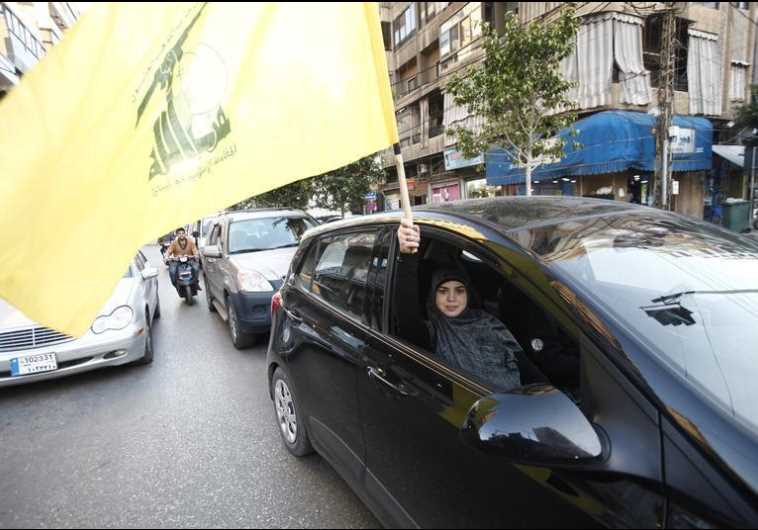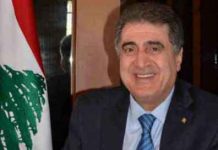How Israel missed an opportunity to cut off Hezbollah’s head
Yossi Melman/Jerusalem Post/March 15/16
‘Hezbollah planned to assassinate Olmert as revenge for hit on arch-terrorist Mughniyeh’
Nasrallah: Israel will always be ‘haunted by the blood’ of Imad Mughniyeh
During May 2000, the IDF’s Military Intelligence branch obtained reports and photographs from observation points and aerial patrols which proved that senior Hezbollah officials were coming from their Beirut headquarters to tour south Lebanon.
The goal of the visit was to check on the IDF’s preparations to withdraw from the security belt in south Lebanon. Hezbollah believed that the IDF would withdraw in July of the same year, and the visits by the organization’s senior figures were being taken in order to come up with a plan to sabotage the withdrawal and launch an attack on the retreating troops.
Military Intelligence and Mossad managed to gather highly accurate intel on the Shi’ite organization’s intentions. “They wanted to turn the withdrawal into an inferno,” says Brig.-Gen. (res.) Amos Gilboa, who wrote a new book that explores the issue, Dawn, the real story of the IDF’s withdrawal from Lebanon, (Dawn was the IDF’s codename for the operation to withdraw from Lebanon). The “repertoire” that Hezbollah’s commanders planned included rocket launches, gunfire at IDF soldiers, setting off of roadside bombs and carbombs, and sending out suicide bombers.
The IDF began a series of discussions about what could be done to stop senior Hezbollah officials from patrolling in south Lebanon. On May 21, Military Intelligence chief Maj.-Gen. Amos Malka held a small meeting. Among those at the meeting were “Little Mofaz,” (Shlomo, the brother of then-IDF chief Shaul Mofaz), who served as the head of the terror department in Military Intelligence’s research division. The book quotes Malka as saying, “Mofaz presented information that the most senior officials in Hezbollah are coming to south Lebanon. It’s a certainty, and we have already made preliminary operational and intelligence preparations among ourselves. This is a one-time opportunity to assassinate them, or at least, their most senior member. We’ll present this to the IDF chief.” Malka intended to ask Mofaz, Shlomo’s brother. “Shlomo,” Gilboa writes, “thought deeply about it and suggested that we pass the responsibility to decide from his brother the IDF chief, to the prime minister or defense minister,” who was then Ehud Barak.
Gadi Eisenkot, current IDF chief of staff who was then Barak’s military secretary and was privy to the classified information, said that Barak was supposed to be in the North the next day, at a ceremony to inaugurate a park. It was decided that after the ceremony, he would arrive at brigade headquarters in the moshav of Shomera. The goal of the consultation was to make a decision whether to take advantage of the opportunity and try to assassinate the senior Hezbollah officials.
What Gilboa does not write in his book, and has already been published in the past by the writer of these lines, is that the senior officials in question were “the Fab Five” of Hezbollah’s military wing. This included the head of the military wing, Imad Mughniyeh, who Israel, it was claimed, had failed to assassinate on a number of occasions and in the end, succeeded in killing in Damascus in 2008; his deputies, Talal Hamia and Mustafa Badr a-Din, (Mughniyeh’s cousin and brother-in-law), who serves as the Shi’te Lebanese group’s military commander today, and two others. One of them was a senior officer in Iran’s Revolutionary Guards who was supervising Hezbollah plans against Israel.
In the early evening, Eisenkot informed Barak of the issue, and he determined that the next morning, when they met at the helicopter launch pad at the Knesset in Jerusalem, he would update him on the details. At the meeting at the launch pad, “Gadi got into a car with the prime minister and the defense minister,” Gilboa writes, “and updated him on the planned assassination of senior Hezbollah officials that Malka was suggesting. Barak listened, and his face lit up when he heard the name of the most senior Hezbollah official,” (meaning Mughniyeh).
Following the conversation, Barak and Eisenkot flew to the North. Barak took part in the park inauguration ceremony and afterward continued on to brigade headquarters in Shomera. There, he was awaited by a few senior IDF officers, including Malka, Shlomo Mofaz, division commander Moshe Kaplinsky, Col. Benny Gantz, who was then the head of the IDF’s liaison unit in Lebanon, and more.
Malka presented the issue of the assassination, but it was clear to those at the meeting that Barak was distracted. He was concerned with the broader problems of planning the IDF’s withdrawal from Lebanon. After a few minutes, Barak stopped Malka. “Continue with the intelligence gathering against the object of the assassination,” he told Malka. To all of those present, his meaning was clear. Barak did not authorize the assassination, or in Gilboa’s words, “The assassination that the meeting was meant to discuss was thrown in the garbage.”
IDF officers present at the meeting, as well as senior Mossad officials that knew of the plan, were disappointed. Everything was ready for the assassination operation. The intelligence was accurate and updated. The operational feasibility was high. Drones and fighter jets were in the air. If Barak had given his approval, the entire leadership of Hezbollah’s military command would have risen skyward. Hezbollah would have been beaten and in shock, and it would have taken the group time to recover from the blow. A golden opportunity was wasted. It would take Israel eight more years and a war (The Second Lebanon War) until the intelligence information and the operational feasibility would meet again and would enable the assassination of Mughniyeh, who was then the most wanted terrorist in the world, not just by Israel, but also by the US.
According to foreign reports, the assassination of Mughniyeh in February 2008 on the outskirts of Damascus was mainly a “blue-and-white” Mossad operation, that was aided by the CIA and carried out in coordination with it in a shared operations room.
The CIA’s contribution was to smuggle in the explosives used in the car bomb that blew up next to Mughniyeh’s car parked near his safehouse in the Syrian capital. Mughniyeh was responsible for, among other things, the planning and activating of the terror attack at the Israeli Embassy in Buenos Aires, which took place 24 years ago this month, in which 29 people were killed, including four Israeli diplomats, one of whom was the Mossad’s representative.
Instead of an assassination in south Lebanon in the summer of 2000, the IDF was forced to carry out what it called “an intelligence exercise,” equivalent to a “dry exercise” – an exercise in which all the elements of an operation are put into action, but without actual fire.
Barak refused to approve the action because he feared the ramifications it would have on his bigger plan. At the meeting in Shomera, and in general after he was chosen to be prime minister in 1999, his interest was to fulfill his election promise: to bring the IDF back from its 18 year presence in the Lebanese mud.
In the beginning, Barak hoped that the withdrawal from Lebanon would be carried out through an agreement or understanding reached between Israel and Syria as mediated by US President Bill Clinton. However, in 2000, after just a few months, he understood that the chances of reaching such an agreement were slim, and he ordered then IDF chief of staff Mofaz to prepare for a withdrawal without an agreement.
Barak kept the decision of the timing of the withdrawal close to his vest. It was dictated mainly by the rapid collapse of the South Lebanon Army (SLA), which the IDF gave control of some of the outposts it evacuated. When Barak understood that the SLA could not hold the outposts, he gathered the commanders of the IDF on the evening of May 22. It was on the same day in which he had earlier rejected the operation to assassinate senior Hezbollah officials. In the meeting he announced that he had ordered IDF chief of staff Mofaz and OC Northern Command Gabi Ashkenazi to complete “their preparations to withdraw all IDF forces and prepare them to redeploy starting tonight.”
“Mofaz almost fell off his chair he was so shocked,” Gilboa writes. This was the height of the drama whose director and lead actor was Barak. Eventually, due to logistical necessities, Ashkenazi succeeded in delaying the date by 24 hours.
Thanks to in house and external compartmentalization, the IDF withdrew without casualties. As a strategic decision, the withdrawal could be considered the crowning glory of Barak’s achievements as prime minister and defense minister. In all of the other fields: security, political and social, history will judge him unfavorably.
The price of the withdrawal was indeed heavy. On the one hand, it is an impressive achievement. Hezbollah did not succeed, as it had planned, to sabotage the withdrawal. However, the withdrawal revealed Israel’s betrayal of the 2,500 SLA soldiers that had worked with them for years, in cooperation and coordination, who all of a sudden, in the dead of night, found themselves running for their lives with their families to Israel.
And in the shadow of these events, the unanswered question remains: Did Barak err by not ordering the assassination of Mughniyeh and the other senior Hezbollah officials, which would have changed the reality between Israel and the Shi’ite organization from Lebanon?




















